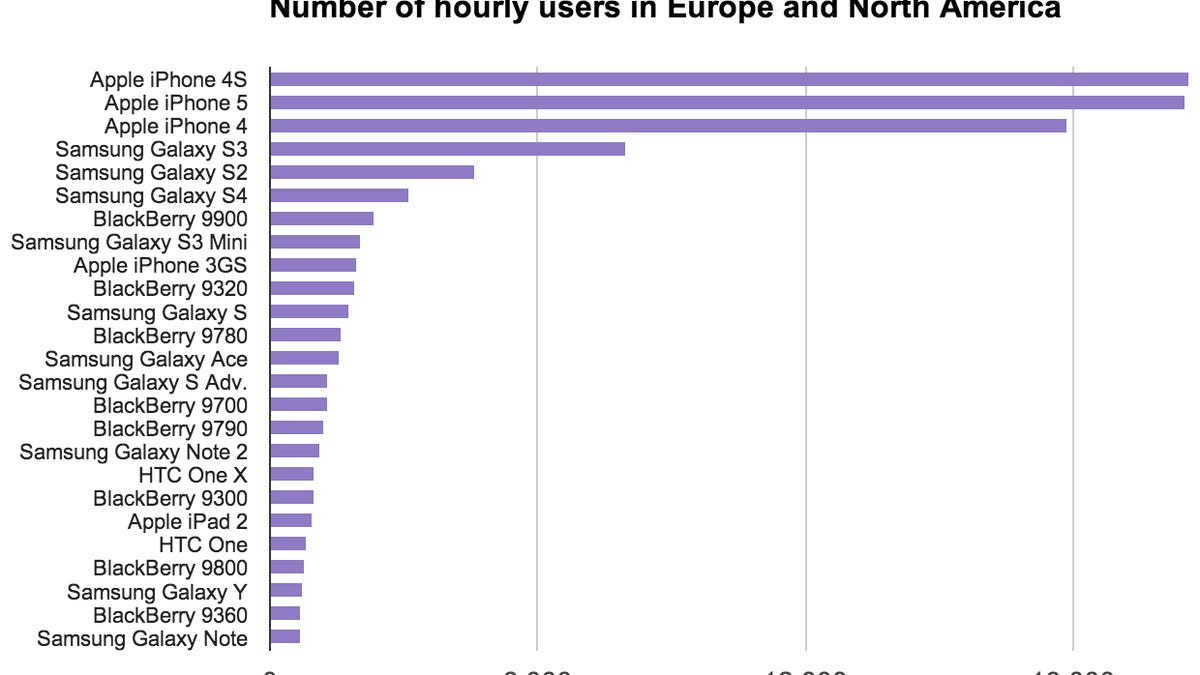iPhones hold top three spots in network usage ranking
Samsung claims fourth through sixth places in Actix's measurements of American and European users. Also: bigger screens and newer phones mean more data use.
What were the top three most used phones in 2013? The iPhone 4S, the iPhone 5, and the iPhone 4, according to an Actix study that tracked communications between mobile devices and carriers' mobile networks.
But Samsung is the clear rival: its Galaxy S3, S2, and S4 claimed the fourth, fifth, and sixth places, respectively, according to figures that Actix, which sells software to track such usage, shared with CNET. Samsung also had a significant presence in the rankings with a handful of lower-end models such as the Galaxy S3 Mini and Galaxy Ace.
The ranking is based on the the number of people who used the phones during several one-hour monitoring periods during the year in North America and Europe.
The iPhone 4S had an average of 20,608 users per hour compared to 20,529 for the iPhone 5, 17,880 for the iPhone 4, 7,973 for the Galaxy S3, 4,603 for the Galaxy S2, and 3,118 for the Galaxy S4.
Actix picked busy times in busy places for its measurements, but it used the same sampling from one period to the next. The figures are based on average hourly usage data collected over the course of 2013, so newer phones such as the iPhone 5S and iPhone 5C, which haven't had as much time to penetrate the market, rank lower.
Although market-share statistics consistently show Android phones outselling iOS phones, network operators and programmers have to deal with a different reality: the number of different phones actually in use. The Actix data shows that for the European and North American markets at least, the iPhone holds a strongly prominent position.
Troublemakers for carriers
Viewed from a carrier perspective, the data reveals which phones are taxing the network the most -- not just by tallying subscribers but also revealing how usage patterns vary from one phone to the next. Actix's statistics show how phones differ in data consumption and in the number of "sessions" -- how often they check into the network to handle calls and data transmission.
Those differences can be interesting. For example:
• Newer phones have a much higher appetite for data. That could be because they use newer, faster networks such as LTE, because they tend to come with higher-resolution screens, and because people use them more and run more apps on them.
• On a per-person basis, Apple phones from a given year consume more data than Samsung's flagship Android phone released the same year.
• Although BlackBerry phones rate relatively high in terms of total users, they consume almost no data compared with Android or iPhone models.
• Big-screen phones download a lot more data -- perhaps because of higher-resolution images and video. However, their relative scarcity means they aren't as much of a burden on networks as high-end smaller phones.
• As manufacturers such as Apple broaden their product lines with more family members, it's rarer for a single model to rank highly in network usage. The iPad 2, for example, is in the top-25 list from Actix, but no other iPad is. (The third-generation iPad was replaced by the fourth-gen model only a few months later.)
Mobile network traffic rocketing
Actix pinned down just how much total data consumption is rising. "Growth was low initially but is now 40 percent year on year, so we are seeing increased growth in a shorter time and no signs of slowing," the company said.
The usage data only is for 2G, 3G and 4G mobile networks. It excludes Wi-Fi connections common at home, work, and other places people regularly use their mobile devices.
Actix said the company doesn't have enough data yet to say anything conclusive about Apple's current flagship iPhone 5S. "Initial data suggests it will track similar to previous iPhones," the company said.
For sessions -- the often-brief network connections phones establish for calls and data transfer -- the iPhone models also led the pack.
Carriers had to grapple with about 1.11 million iPhone 4S sessions each hour compared with about 1.08 million for the iPhone 5, 832,000 for the iPhone 4, 360,000 for the Galaxy S3, 382,000 for the Galaxy S2, 130,000 for the iPhone 3GS, 129,000 for the HTC One X, 104,000 for the BlackBerry 9900, and 100,000 for the Galaxy S4.
New phones demand more data
Breaking down the data by individual use shows the increasing data appetite by phone. On average, each iPhone 3GS user consumed 2.1MB per hour, an iPhone 4 user 4.5MB per hour, an iPhone 4S user 6.4MB, and an iPhone 5 user 8.8MB. Those phones were released in 2009, 2010, 2011, and 2012, respectively.
Newer Samsung phones also consume more data, but the increase is a step behind Apple models, according to the Actix figures. Galaxy S users consumed 2.79MB per hour compared to 3.9MB for the Galaxy S2, 5.5MB for the Galaxy S3, and 6.6MB for the Galaxy S4. Those phones were released in 2010, 2011, 2012, and 2013, respectively.
Judged purely on the basis of megabytes consumed, big-screen devices like phablets and tablets have a larger appetite for data.
The Samsung Galaxy Note 2 consumed an average of 8.4MB per hour, though it ranked 17th in terms of network-connection sessions. The HTC One X, in 18th place, consumed 5.4MB per hour. And the iPad 2, in 20th place, consumed a whopping 15.4MB per hour.


